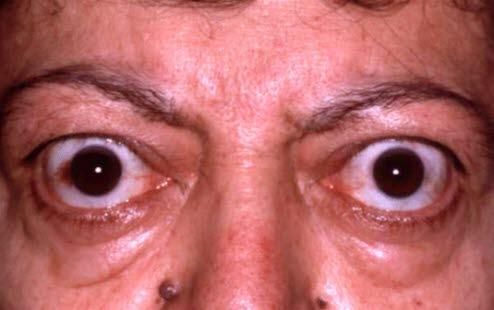Øyeforandringer ved høyt stoffskifte, eksoftalmus
Høyt stoffskifte kan gi øyeforandringer, først og fremst karakterisert ved utstående øyne, eksoftalmus. Symptomer er at øynene blir utstående, men også smerte, trykkfølelse bak øynene, ruskfølelse, tåreflod, lysskyhet og dobbeltsyn.

Sist oppdatert:
17. juni 2019
Øyeforandringer ved høyt stoffskifte, hypertyreose, skyldes at kroppens eget immunforsvar går til angrep på vevet bak øyet, en autoimmun reaksjon. Forandringene er i første rekke forbundet med forhøyet stoffskifte ved såkalt Graves sykdom (Morbus Basedow), og 20-25 prosent av disse pasientene har øyeforandringer når de tar kontakt med lege. Tre til fem prosent av alle med Graves sykdom utvikler alvorlig øyesykdom.
Vil du vite mer
Dette dokumentet er basert på det profesjonelle dokumentet Øyeforandringer ved hypertyreose . Referanselisten for dette dokumentet vises nedenfor
- Cawood T, Moriarty P, O'Shea D. Recent developments in thyroid eye disease. BMJ 2004; 329: 385-90. PubMed
- Rødahl E, Kloster R, Eidal K. Endokrin eksoftalmus. Norsk kvalitetshåndbok i oftalmologi. Nov 2016. legeforeningen.no
- Tanda ML, Piantanida E, Liparulo L, et al. Prevalence and natural history of Graves' orbitopathy in a large series of patients with newly diagnosed graves' hyperthyroidism seen at a single center. J Clin Endocrinol Metab 2013; 98:1443. PubMed
- Bartalena L, Pinchera A, Marcocci C. Management of Graves' ophthalmopathy: reality and perspectives. Endocr Rev 2000; 21: 168-99. PubMed
- Vestergaard P. Smoking and thyroid disorders - a meta-analysis. Eur J Endocrinol 2002; 146: 153-61. PubMed
- Khong JJ, Finch S, De Silva C, et al. Risk Factors for Graves' Orbitopathy; the Australian Thyroid-Associated Orbitopathy Research (ATOR) Study. J Clin Endocrinol Metab 2016; 101:2711. PubMed
- Davies TF, Burch HB. Clinical features and diagnosis of Graves' orbitopathy (ophthalmopathy). UpToDate, last updated Feb 27, 2018. UpToDate
- Lin LK, Andreoli CM, Hatton MP, Rubin PA. Recognizing the protruding eye. Orbit. 2008. 27(5):350-5.
- Marcocci C, Kahaly GJ, Krassas GE, et al. Selenium and the course of mild Graves' orbitopathy. N Engl J Med 2011; 364: 1920-31. New England Journal of Medicine
- Eckstein A, Quadbeck B, Mueller G, Rettenmeier AW, Hoermann R, Mann K, et al. Impact of smoking on the response to treatment of thyroid associated ophthalmopathy. Br J Ophthalmol 2003; 87: 773-6. British Journal of Ophthalmology
- Salvi M, Campi I. Medical Treatment of Graves' Orbitopathy. Horm Metab Res 2015; 47:779. PubMed
- Hart RH, Perros P. Glucocorticoids in the medical management of Graves' ophtalmopathy. Minerva Endocrinol 2003; 28: 223-31. PubMed
- Aktaran S, Akarsu E, Erbagci I, Araz M, Okumus S, Kartal M. Comparison of intravenous methylprednisolone therapy vs. oral methylprednisolone therapy in patients with Graves` ophthalmopathy. Int J Clin Pract 2007; 61: 45-51. PubMed
- Wiersinga WM, Smit T, Schuster-Uittenhoeve AL, van der Gaag R, Koornneef L. Therapeutic outcome of prednisone medication and of orbital irradiation in patients with Graves’ ophthalmopathy. Ophthalmologica 1988; 197(2): 75-84. PubMed
- Mourits MP, van Kempen-Harteveld ML, Garcia MB, Koppeschaar HP, Tick L, Terwee CB. Radiotherapy for Graves' orbitopathy: randomised placebo-controlled study. Lancet 2000; 355: 1505-9. PubMed
- Gorman CA, Garrity JA, Fatourechi V, Bahn RS, Petersen IA, Stafford SL, et al. A prospective, randomized, double-blind, placebo-controlled study of orbital radiotherapy for Graves' ophthalmopathy. Ophthalmology 2001; 108: 1523-34. PubMed
- Prummel MF, Terwee CB, Gerding MN, Baldeschi L, Mourits MP, Blank L, et al. A randomized controlled trial of orbital radiotherapy versus sham irradiation in patients with mild Graves' ophthalmopathy. J Clin Endocrinol Metab 2004; 89(1): 15-20. PubMed
- Perros P, Neoh C, Dickinson J. Thyroid eye disease. Clinical review. BMJ 2009; 338: b560. BMJ (DOI)
- Terwee C, Wakelkamp I, Tan S, Dekker F, Prummel MF, Wiersinga W. Long-term effects of Graves’ ophthalmopathy on health-related quality of life. Eur J Endocrinol 2002; 146(6): 751-7. PubMed